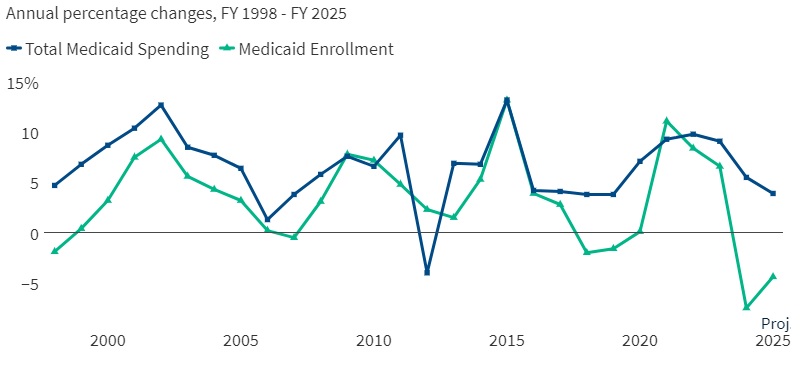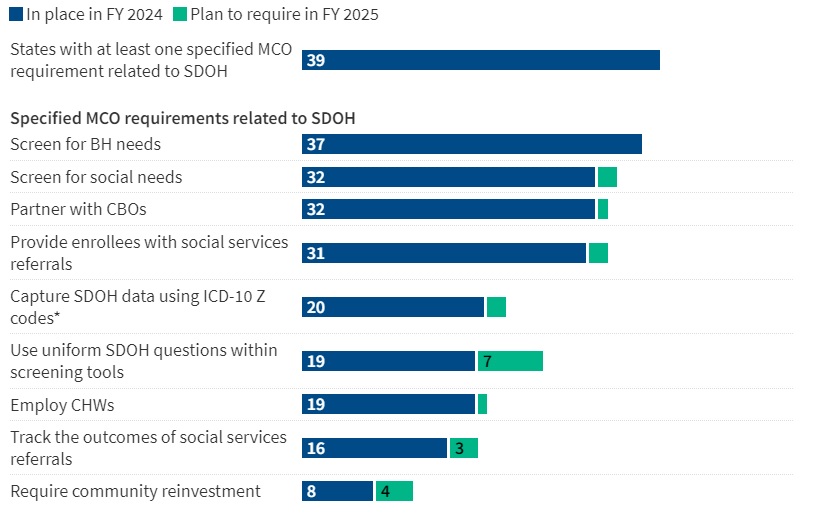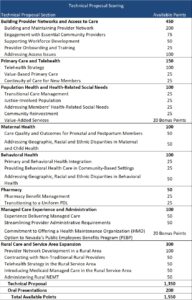This week’s In Focus section examines a comprehensive proposed rule that the Centers for Medicare & Medicaid Services (CMS) released on November 26, 2024. These highly anticipated regulations—which represent the last major Medicare regulations from the Biden Administration—include several significant and far-reaching proposals designed to strengthen plan oversight and enhance beneficiary protections for millions of Medicare beneficiaries who have coverage through Medicare Advantage and Medicare Part D plans beginning in contract year 2026. The rule also comprises proposals with fiscal and policy implications for state Medicaid programs.
Comments on the proposed rule are due by January 27, 2025, and the incoming Trump Administration could make significant changes before finalization. New administration officials may choose to delay certain provisions, scale back, or eliminate certain proposed policy changes when they finalize the regulations next year.
This article explains several of the proposed policies, considerations for healthcare stakeholders, and developments that Health Management Associates (HMA) experts will be tracking in the coming weeks.
Coverage of Anti-Obesity Medications Under Medicare Part D and Medicaid
In the proposed regulations, CMS seeks to expand coverage of anti-obesity medications (AOMs) under the Medicare Part D and Medicaid programs. Under current Medicare Part D coverage rules, medications used exclusively for weight loss are excluded from the definition of a Part D covered drug. Through the proposed change, CMS is seeking to align Medicare and Medicaid coverage policy with the prevailing medical consensus that recognizes obesity as a chronic disease.
Under the proposed reinterpretation, CMS would expand eligibility for Part D coverage of AOMs for Medicare beneficiaries with obesity. AOMs used for weight loss or chronic weight management would continue to be excluded from Part D coverage under the proposed regulation.
As it relates to Medicaid, CMS’s proposed reinterpretation would require Medicaid coverage for anti-obesity medications when used for weight loss or chronic weight management for the treatment of obesity. State Medicaid programs would continue to have discretion to use preferred drug lists and prior authorization (PA) to establish certain limitations on the coverage of these drugs, consistent with existing statutory requirements.
CMS estimates the proposal would increase federal costs by $24.8 billion as the result of expanded Part D coverage and $14.8 billion because of expanded Medicaid coverage over a 10-year period.
Key considerations: Though expanded access to innovative medications may improve access and outcomes for obese patients, these considerations may need to be balanced against the proposal’s considerable fiscal costs. In addition, key health nominees put forth by President-Elect Donald J. Trump have different views about how best to prevent and treat chronic disease, creating additional uncertainty about whether this proposed expansion will go forward.
Strengthening Prior Authorization and Utilization Management Guardrails
The proposed rule includes a series of recommendations for reforming Medicare Advantage PA, utilization management (UM), and coverage decisions, which include:
- Defining the meaning of internal coverage criteria to clarify when MA plans may apply UM
- Ensuring MA plans’ internal coverage policies are transparent and readily available to the public
- Requiring plans to inform beneficiaries of their appeal rights
- Revising the current metrics for the annual health equity analysis on the use of PA to require more detailed and granular reporting to allow CMS to determine whether MA plans disproportionately deny certain services
Key considerations: Continued scrutiny of MA plans’ PA practices and strong bipartisan support for reforms increase the likelihood that certain changes will be made to these policies within the next year.
Enhancing Medicare Plan Finder to Include Information on Plan Provider Directories
Another notable proposal would require MA plans to make provider directory data available to CMS for inclusion in Medicare Plan Finder (MPF), the online tool that allows beneficiaries to compare coverage options, including Medicare Advantage and Part D plans. At present, provider directories must be accessible on MA plans websites.
CMS seeks to enhance MPF with searchable provider information for all MA plans while requiring plans to attest to the accuracy of the provider directory data, including updating data within 30 days of receiving notification that provider information has changed. CMS would ensure compliance with this expectation by requiring plans to meet data compliance and quality checks, which will be detailed in upcoming technical guidance.
Improving Access to Behavioral Health Care
The proposed rule furthers federal policymakers’ initiatives to address the nation’s behavioral health crisis. CMS proposes to establish the following three standards to ensure that beneficiary cost sharing in Medicare Advantage is no greater than in Traditional Medicare:
- A 20 percent coinsurance or an actuarially equivalent copayment rate for mental health specialty services, psychiatric services, partial hospitalization, and outpatient substance abuse services
- No cost sharing for opioid treatment programs
- All (100 percent) of the estimated Traditional Medicare cost sharing for inpatient psychiatric services
Improve Oversight and Administration of Supplemental Benefits
MA plans may offer a variety of supplemental benefits such as vision, dental, and gym memberships, which have come under increasing scrutiny by CMS. CMS proposed several actions to reduce misuse of these benefits, including:
- Outlining proper usage by MA organizations and enrollees
- Adding disclosure rules for transparency
- Ensuring enrollees can access covered services through alternative methods
- Requiring real-time electronic links between debit cards and covered services
- Defining acceptable over-the-counter products.
Key Considerations: CMS officials in President-Elect Trump’s first administration expanded flexibility for plans to offer supplemental benefits. Incoming policy officials may seek an opportunity to fully review the Biden Administration’s proposals. Data and experience-informed comments from MA plans and stakeholders can support such discussions.
Improve Care Experience for Dual Eligibles
CMS proposed the following two new federal requirements for Dual Eligible Special Needs Plans (D-SNPs) that are applicable integrated plans (AIPs):
- AIP D-SNPs will need to have integrated member ID cards for their Medicare and Medicaid plans.
- D-SNPs will be required to conduct an integrated health risk assessment for Medicare and Medicaid, rather than separate ones for each program.
Key Considerations: These proposals further CMS’s multi-year work to advance integrated care by applying Medicare-Medicaid Plan features into D-SNP requirements. States and MA and Medicaid plans should plan for operational and policy changes if the proposals are finalized.
Formulary Inclusion and Placement of Generics and Biosimilars
CMS proposes to require Part D formularies to provide beneficiaries with broad access to generic, biosimilar, and other low-cost drugs while also ensuring that tier placement and UM practices do not limit access to these drugs as compared with more expensive brand name and reference products.
Key considerations: If finalized, the proposal would require MA-PD and Part D plans to update their approach and considerations for plan formulary development. Consumer groups and other stakeholders should consider the possibility that the proposal will improve access to lower cost products.
Other Topics in the Proposed Rule
In addition, the proposed rule calls for the following:
- Guardrails for artificial intelligence to protect access to health services, such as requiring that MA plans ensure services are provided equitably, regardless of delivery method or origin (i.e., human or automated systems)
- Changes to MA and Part D medical loss ratio (MLR) reporting to improve the meaningfulness and comparability of MLR across plan contracts
- Expanded Part D medication therapy management eligibility criteria
- Adding and updating measures addressed in this proposed rule, beginning with the 2028 Star Ratings
- Promoting community-based services and enhancing transparency of in-home service providers, including new definitions and standards for community-based organizations
- Codifying existing guidance related to implementation of the Medicare Prescription Payment Plan, which is part of the Inflation Reduction Act (IRA)
What to Watch
During the lame duck session, Congress could advance legislation related to some proposals in this rule. Specifically, PA has been an area of significant bipartisan interest, along with access to and cost of GLP-1 products. CMS will need to ensure the final MA and Part D policy and technical rule for contract year 2026 reflects approved statutory changes.
In addition, HMA is watching key appointments within the US Department of Health and Human Services, including individuals selected to lead CMS’ Medicare and Medicaid centers. These appointments will provide valuable insights on the emerging policy agenda of the incoming administration.
Connect with Us
HMA’s Medicare and Medicaid experts will continue to assess and analyze the policy and political landscape, which will determine the final policies in the MA and Part D policy and technical rule for contract year 2026. HMA’s experts have the depth of knowledge, experience, and subject matter expertise to assist organizations that engage in the rulemaking process and to support implementation of final policies, including policy development, tailored analysis, and modeling capabilities, as well as quality improvement initiatives and plan benefit design.
For further analysis of the MA and Part D proposed rule and potential impact on MA and Part D plans, Medicaid programs, providers, and beneficiaries, contact our featured experts below.









